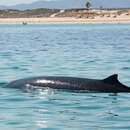External Morphology
(
Anglèis
)
fornì da EOL authors
Head Shape The melon bulges slightly anterior to the blowhole and slopes smoothly to the short beak. The mouthline arches strongly in males, though this sinusoidal curves is less pronounced in females and juveniles. Coloration Adults of both sexes have a similar pigmentation pattern. Dark gray dorsally, laterally, and grading to a lighter gray ventrally, especially posterior to the navel and on the underside of the beak. The coloration of calves reflects adult color, brown on dorsum and lateral sides and becoming grayish white on the ventral surface. The lighter color also extends up posterior and dorsal to the eye. The beak is grayish white with a brown tip, small brown patches are present near the angle of the mouth and between the throat grooves. Size Adult body length range is unknown. Recorded maximum body length for adult males and females is 3.7 m and 3.6 m, respectively. Length at birth is 1.6 m. Most Likely Confused With: Mesoplodon densirostris Mesoplodon perrini
- licensa
- cc-by-3.0
- drit d'autor
- Smithsonian National Museum of Natural History Marine Mammal Program
Skull morphology
(
Anglèis
)
fornì da EOL authors
Diagnostic features of the skull and mandible On the vertex of the dorsal skull the premaxillary bone extends forward of the nasal and frontal bones. Separates from Berardius and Ziphius. A sulcus (groove) running along the middle of the combined surfaces of the nasal bones so depresses their combined middle that it is the lateral portion of each nasal bone that reaches farthest forward on the vertex. Separates from Tasmacetus and Indopacetus. When the skull is upright and the long axis of the anterior half of the beak is horizontal, a horizontal plane transecting the summit of either maxillary prominence transects the mesethmoid bone. Separates from Hyperoodon. Tooth alveoli of mandible are positioned posterior to the mandibular symphysis .Separates from M. bidens, M. bowdoini, M. carlhubbsi, M. europaeus, M. grayi, M. hectori, M. layardii, M. perrini, and M. traversii. Right premaxilla extends posteriorly beyond the right nasal a distance exceeding 70% of dorsal length of right nasal. Separates from M. gingkodens. Antorbital notches form acute angles. Separates from M. densirostris and M. stejnegeri.
- licensa
- cc-by-3.0
- drit d'autor
- Smithsonian National Museum of Natural History Marine Mammal Program
Standing distribution
(
Anglèis
)
fornì da EOL authors
Stranding Distribution Known from strandings and by-catch in Pacific waters of southern California, Mexico, and Peru. One stranding is recorded from New Zealand, though this animal is possibly extralimital. The total species range includes much of the eastern tropical Pacific, as well as the western South Pacific.
- licensa
- cc-by-3.0
- drit d'autor
- Smithsonian National Museum of Natural History Marine Mammal Program
Tooth Morphology
(
Anglèis
)
fornì da EOL authors
Tooth position A single pair of teeth are positioned on the elevated section of the mandible. Subadult animals have teeth that are inclined anteriorly at an angle of 20 to 40 degrees relative to the long axis of the mandible. However, in adult males the long axis of the teeth are almost perpendicular to the long axis of the mandible. Tooth exposure Erupted teeth in adult males are covered by gum tissue, with only the tip of tooth exposed. Females and juveniles do not have erupted teeth. Tooth shape The teeth are are ovate in cross section.
- licensa
- cc-by-3.0
- drit d'autor
- Smithsonian National Museum of Natural History Marine Mammal Program

